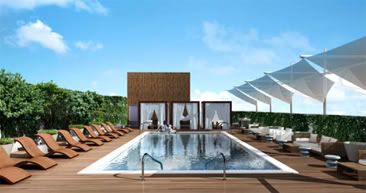
Most of us have recognized that the slowdown in the residential real estate market has negatively affected development. Half a dozen downtown residential developments in downtown Long Beach have been scrapped: another half-dozen are being redesigned or the schedule to build them has been slowed down. In fact, the only two residential developments currently underway—one on the Promenade and the other in the West Gateway area—are both rental projects. However, not all is lost. Despite the slowdown, the momentum to renew Long Beach’s downtown continues to be realized in the form of several hotel developments. There are, for instance, currently two new hospitality projects under construction in the Shoreline area: a boutique hotel called Avia to be located at the Pike, and a twelve-story Marriot Residence Inn to be located along Queensway Drive, toward the port. Lodgeworks, the developer of the Avia hotel project, is also proposing to build an extended-stay hotel, “Hotel Sierra,” across Bay Street from the new Avia hotel, filling in a key empty lot at the Pike.
Along as well as north of Ocean Boulevard, proposals exist for six additional hotels. As reported in the Press-Telegram, a Hyatt Place and Aloft hotel have been proposed for the block situated west of Long Beach Boulevard, between the First Street transit mall and Broadway. According to Downtown Long Beach Associates, a new Marriot Hotel is being proposed at the southeast corner of Ocean Boulevard and Pine Avenue; additionally, a boutique hotel named Hotel Esterel has been proposed for the west side of the Promenade, between Broadway and Third Street. The Ocean Center building at the southwest corner of Ocean Boulevard and Pine Avenue has recently received approval from the city’s Cultural Heritage Commission to be converted into a boutique hotel with lofts on the higher floors. According to the city website, there is also a proposal for hotel and residential development just west of the new West Ocean residential towers on Ocean Boulevard, across from the city courthouse.
All in all, nine new hotels are either proposed or under construction. Were all these hotels to be completed, they would provide nearly 1,500 additional rooms in the downtown area. These projects would clearly help to maintain momentum for redeveloping downtown Long Beach, in particular by closing gaps in the urban fabric. These 1,500 new rooms would serve our convention and tourist economy—all the while adding a significant amount of pedestrian activity in some of the downtown’s core areas, including Pine Avenue and the Shoreline area.
However, given the sheer quantity of this new development—development of a singular type, the hotel—it behooves us to pause and ask how downtown Long Beach could most effectively take advantage of this opportunity. For instance, it bears noting that the Shoreline Boulevard area represents land designated as a tidelands trust; it is thus public land heavily regulated by the California State Coastal Commission. The city created a specific zoning district to guide development in the Shoreline area, much like the Southeast Area Development and Improvement Plan (SEADIP) focusing on the east side of the city, or the Downtown Planned Development District (PD-30). The planned development district created for the Shoreline area includes all land south of Ocean Boulevard to the water, but also includes land-use limitations for the area south of Seaside Way. This is because those lands are public owned; as a result, they must retain some level of public access. This ranges from public park space and civic amenities to commercial uses such as retail, restaurants and limited office space. Residential development is explicitly disallowed. What is particularly germane is that public access to the coastline can also be fulfilled through hotel development, because theoretically everyone has the right to stay in such facilities.
In other words, an opportunity presents itself to turn an ostensible land-use “restriction” in regard to residential construction into an opportunity to provide the mix of uses necessary to create a 24-hour, active urban environment. Unfortunately, the exclusion of residential development from the Shoreline area has resulted in less-than-vibrant district. Barring rewriting the California Coastal principles so as to allow residential development—a possibility as unlikely as it is ill-advised—hotels present the only option for getting persons on the street to produce a flourishing urban milieu.
The question, then, is how Long Beach can focus this new surge of hotel development where it is most needed. The two new hotels at the Pike discussed above—the Avia and the Hotel Sierra—are certainly steps in the right direction. There are roughly fifteen acres of land available for development east of the convention center. Currently an expansive parking lot serving the convention center and performing arts center, this is a stunningly inappropriate use for prime downtown waterfront land that features gorgeous views of the Pacific Ocean, the Queen Mary, and the downtown skyline. Transforming this area into a hospitality quarter could provide much-needed economic development, as well as bringing pedestrian activity to the Shoreline area.
Thinking through these kinds of possibilities crucial because while a slowdown in residential development currently exists, this is unlikely to last. Some developers are already moving forward with gaining City approval for new construction projects, designed in anticipation of the next real estate surge. Long Beach can negotiate development rights along the waterfront in exchange for securing those proposed sites. Focusing new hotel development in the Shoreline area is one way to work proactively and creatively to take advantage of our city’s greatest asset—indeed, the source of its name. There remains a distressing tendency for Long Beach to “turn its back” on its precious downtown waterfront. Sharing that waterfront with our visitors can help create a vibrant street life, and this could not help but make this city a better place for everyone.

The Avia roof deck (courtesy of Lodgeworks)


